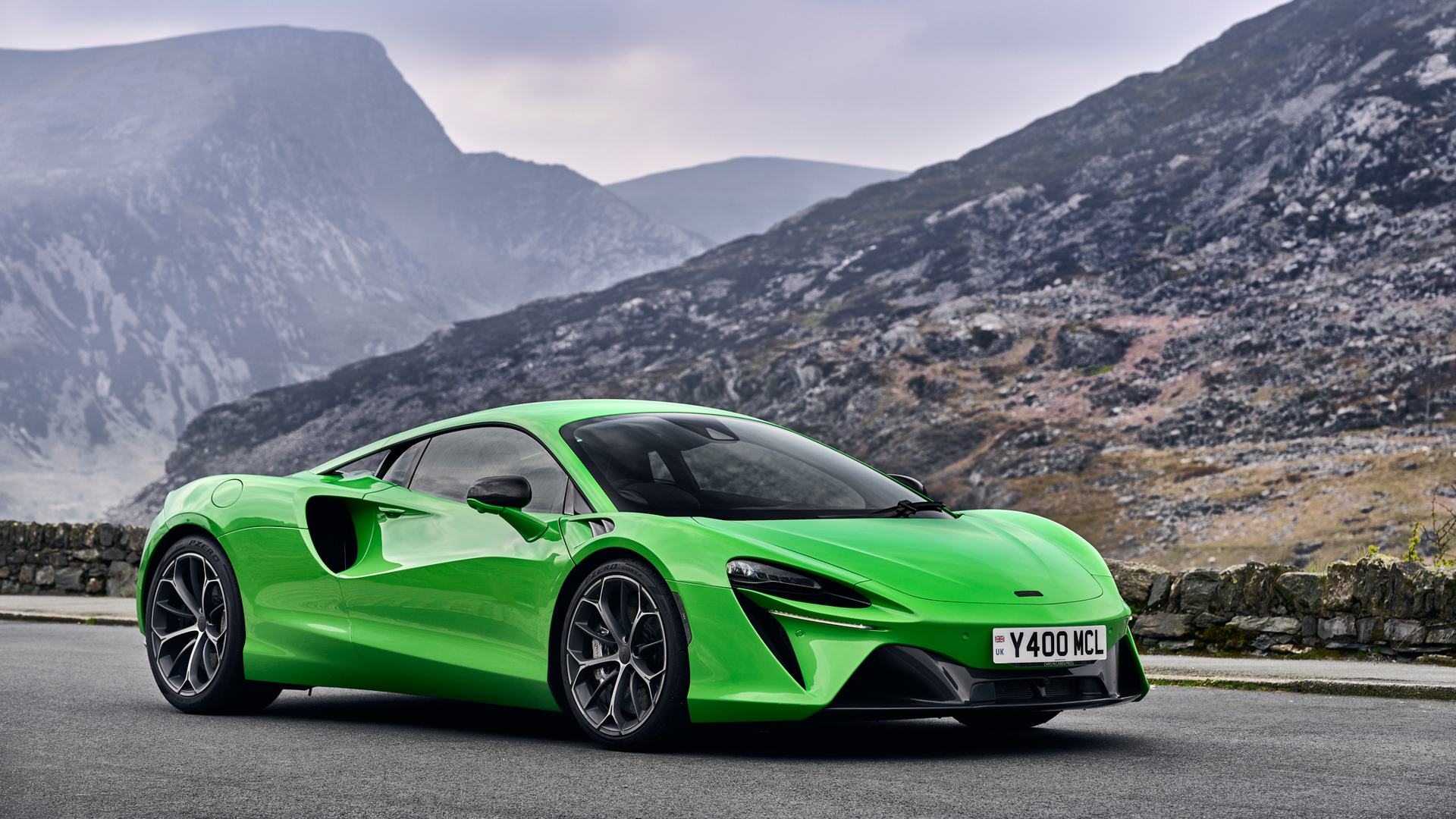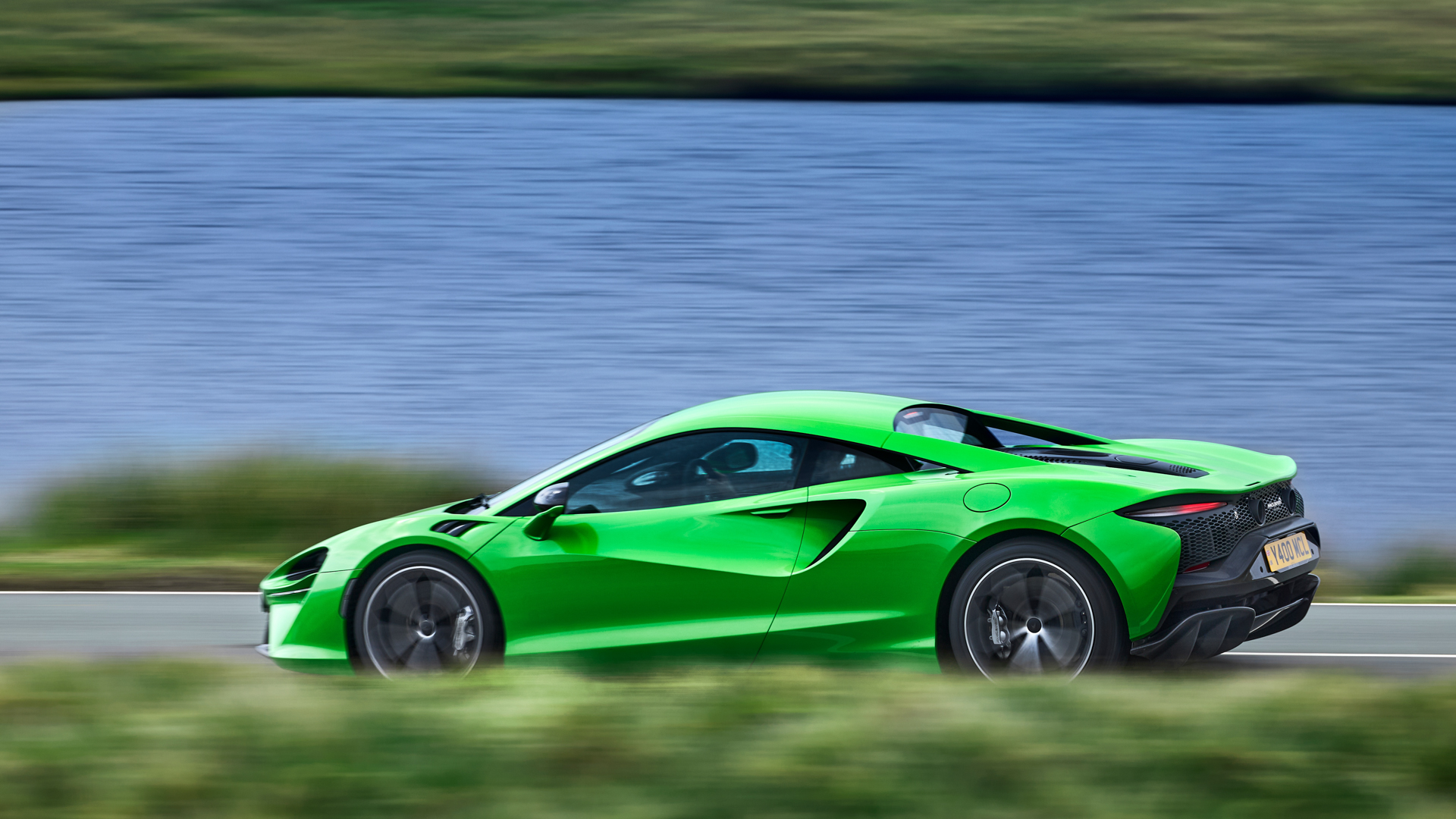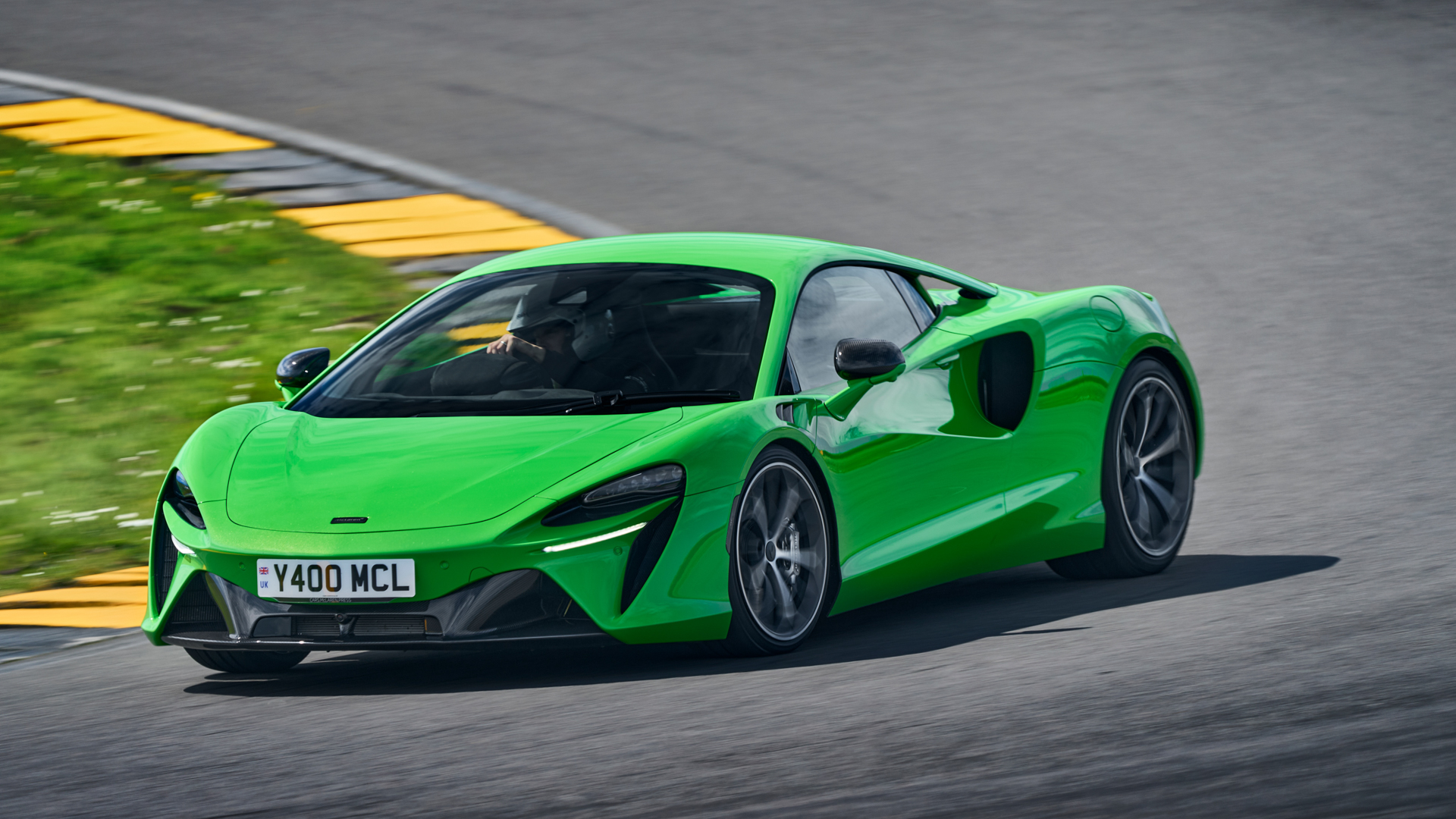McLaren Artura Coupe review: a plug-in hybrid supercar that does it all
A supercar you’ll want to use every single day


The McLaren Artura is a 200 mph supercar that also acts as a conventional hybrid. It’ll drive silently through traffic – or at up to 80 mph – in electric-only mode, then transform into a fully-fledged supercar with the flick of a switch. There’s masses of performance on offer from the twin-turbocharged V6 engine, while both the steering and ride quality are among the very best. Add this to the Artura’s compact dimensions, comfortable interior, decent storage and practicalities like the nose lift and Bowers & Wilkins sound system, and you have one of the most complete supercars of all time.
-
+
Huge breadth of ability
-
+
Useful EV mode
-
+
Fantastic performance
-
-
Optional extras quickly get expensive
-
-
Lack of physical controls
-
-
Doesn’t fly below the radar
Why you can trust T3

It’s hard to believe that a decade has already passed since the introduction of the McLaren P1. Alongside the awkwardly named Ferrari LaFerrari and Porsche 918 Spyder, the P1 demonstrated that hybrid technology can add to the supercar experience, not neuter it. The idea of a fully-electric supercar from brands like McLaren, Porsche and Ferrari is still something we’ll have to grapple with at a later date, but for now we’ve just hopped onto the next stepping stone to electrification.
Costing almost £1m and limited to 375 examples, the P1 was part-hypercar, part-proof of concept. It showed that a tiny battery can be used to make a performance car even quicker, but it could only manage six miles on electric power alone. Its hypercar credentials meant it could never act as a daily driver.
Ten years later, McLaren now has the Artura, a hybrid supercar that is mass-produced and costs less than a quarter of the P1. It accelerates almost as quickly and has a similar top speed, yet offers about 20 miles of electric range and can achieve a real-world fuel efficiency of over 30 MPG.
Although it only arrived in 2024, for the 2025 model year car featured in this review McLaren has updated the Artura Coupe to match the performance and spec of the newer Artura Spider convertible.
Price and availability

Available now, the McLaren Artura is priced from £201,400.
The car driven for this review was fitted with a number of optional extras, including Mantis Green paint (£4,400), the Performance interior pack with Nappa leather and Alcantara (£5,050), a sports exhaust (£4,700), a nose lift system crucial for tackling speed bumps (£2,200), ‘super-lightweight’ wheels (£4,500), a technology pack that includes a 12-speaker Bowers & Wilkins sound system, 360-degree parking camera and wireless phone charging (£6,800), and carbon fibre extras on the exterior and interior totalling £25,200.
The total cost of the car reviewed here was £257,480.
Get all the latest news, reviews, deals and buying guides on gorgeous tech, home and active products from the T3 experts
Features and design

The big feature here is of course the Artura’s hybrid drivetrain. It comprises a twin-turbocharged 3.0-litre V6 engine and a 7.4 kWh battery pack powering an electric motor installed between the engine and its eight-speed, dual-clutch automatic gearbox.
The Artura works just like other plug-in hybrids. It can function on electric power alone – indeed, that’s how it switches on by default – or it can be left to turn the engine on and off as it sees fit. You can then tell it to charge the battery more aggressively (using the engine and energy recovering when braking) if you need it. Another drive mode uses the engine and motor to give maximum performance.
Despite the clever hybrid drivetrain underneath, the Artura still fits the mould of a traditional supercar. There are two vertically-hinged doors, two seats and an engine in the middle that sends all of its power to the rear wheels. McLaren’s house style has changed very little over the last decade, to the point where it can be tricky to tell its various models apart. This is true too with the Artura, but for me that’s no bad thing. They might all look similar, but McLarens all look great, to my eyes at least.
The Artura is fairly compact for a supercar. You won’t want to try squeezing it through London’s width-restricted roads (especially those that are just 6ft 6in), but it doesn’t otherwise feel intimidating to drive. You can thank the excellent visibility for that.
It’s also surprisingly practical for a supercar. There’s easily enough space under the nose for a couple of soft weekend bags, plus a useful shelf behind the seats too. Spending £2,200 on the nose lift system is absolutely crucial, since this quickly raises the nose via a dashboard button and gives the Artura more ground clearance than a current-generation BMW M3. The McLaren easily cleared every speed bump I encountered, and even managed to clamber onto my driveway, which despite having a dropped kerb still likes to scrape the nose and even the sills of my Mazda MX-5. This really is a practical supercar, and one I can imagine using almost every day.
Technology

It would be fair to say McLaren has previously struggled to offer a steller infotainment system. The Artura’s is an improvement, but it still takes a bit of getting used to. The portrait-orientated display is navigated by touch, as well as a physical scroll wheel mounted to its side. The huge black borders make the display look dated, but at least the user interface’s simplicity reduces distraction. I’d rather McLaren installed a set of nice, tactile controls for cabin temperature, but that’s just not the trend at the moment, even among supercar makers not laser-focused on cost saving.
As always, I imagine the vast majority of Artura owners will plug in their iPhone and use Apple CarPlay exclusively. I also suspect many will pay for the upgraded Bowers & Wilkins stereo, which has 12 speakers and sounds absolutely fantastic. Not cheap though, as it comes as part of the £6,800 Technology Pack, which also includes wireless phone charging, adaptive LED headlights and a 360-degree parking camera.
Performance and drive

The Artura produces 691 horsepower, of which 94 hp comes from the electric motor and the rest is provided by the 3.0-litre, twin-turbo V6 engine. Add this to the relatively low weight, for a hybrid supercar, of between 1,395 and 1,498 kg (depending on lightweight options, fuel etc.), and the result is 0-60 mph in 3.0 seconds. Standstill to 124 mph (200 km/h) takes just 8.3 seconds, 186 mph (300 kn/h) takes 21.5 seconds and the top speed is electronically limited to 205 mph.
Needless to say, the McLaren feels every bit as quick as those figures suggest. But it never feels especially wild. This isn’t an unhinged supercar with a spike of turbo-lag lurking around every corner. It doesn’t give the impression that it’s trying to scare you. This is a modern supercar. It’s on your side.
It doesn’t explode into life – it actually starts in all-electric mode by default to help improve efficiency during emissions test cycles and thus lower the sales tax in some markets – and nor is it too loud during regular driving.
As much as the Artura is fun to drive quickly, I equally enjoyed how it’ll crawl silently through city traffic. The incredibly bright green paintwork of this particular car was loud enough without the engine constantly grumbling away while sat at traffic lights. I felt the silence and lack of emissions showed passers-by that I was doing my bit; that despite driving a supercar I was also in a hybrid with the engine off. A neighbour even asked if the car was all-electric, as he’d seen me set off silently the previous day.
The McLaren’s eco credentials in traffic mean that, when you finally come across an enticingly empty country road, there are no regrets. Switch the drivetrain to Sport – using a rocker switch that’s part of the instrument binnacle and cleverly within reach of your fingers while holding the wheel – drop a few gears, and the Artura takes off. The electric motor does its best to deliver instant acceleration, but there’s still a hint that this car is turbocharged, especially at lower revs.
It’s as quick as any supercar needs to be, and the steering is fabulous. The wheel itself has no buttons or switches at all, and both the quality and quantity of information it gives the driver is world-class. It’s a cliche, but the Artura is one of those cars that you simply think around each corner, such is the connection you have between your fingertips and the tyres below.
There’s also masses of traction and, while the Artura misses out on the clever cross-linked hydraulic dampers of more expensive McLarens, it still rides very well. It can feel a little firm on rough roads at slow speeds, but this is a carbon-tubbed supercar so that’s absolutely to be expected.
And that isn’t to say the Artura can’t cope with long journeys. I spent several hours at a time in it, covering all manner of road types, and it’s perfectly comfortable – even surprisingly so for a supercar.
Should I buy the McLaren Artura?

The breadth of the Artura’s abilities is what impresses most of all. Here is a supercar that looks the part and is properly quick, yet also manages just fine in town and city traffic, is perfectly practical for a weekend away, and works just like any other hybrid. It’ll manage a dozen or so real-world miles in EV mode, cruise quietly on the motorway while you listen to a podcast, then deliver serious supercar thrills when you want them, and all without scaring its driver. It isn’t the loudest car around, but the V6 with its sports exhaust still sounds fantastic at higher revs, dismissing any concerns you might have about this McLaren lacking a V8.
It also rides well and the steering is superb. I want to describe the Artura as an everyday supercar. Not because it’s a bit too plain to be special, but because if I owned one I’d find an excuse to drive it every day.
It’ll manage an office commute just fine (and entirely on electricity if you’re just going a few miles, thus costing you almost nothing) and it’ll even manage a trip to the shops, thanks to the compact dimensions and decent boot. Or you can take it on a track day and discover how the same hybrid system that got you through London on EV power alone is now catapulting you out of the corners.
Pick a more sensible colour and it’ll even do all this without drawing any attention to itself. Want something more exotic than a Porsche 911 Turbo S, but can’t quite bring yourself to go Italian? Here’s your answer.
Alistair is a freelance automotive and technology journalist. He has bylines on esteemed sites such as the BBC, Forbes, TechRadar, and of best of all, T3, where he covers topics ranging from classic cars and men's lifestyle, to smart home technology, phones, electric cars, autonomy, Swiss watches, and much more besides. He is an experienced journalist, writing news, features, interviews and product reviews. If that didn't make him busy enough, he is also the co-host of the AutoChat podcast.
